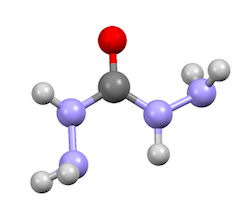Chemistry:Carbohydrazide

| |

| |
| Names | |
|---|---|
| IUPAC name
1,3-Diaminourea
| |
| Identifiers | |
3D model (JSmol)
|
|
| ChEBI | |
| ChemSpider | |
| EC Number |
|
PubChem CID
|
|
| UNII | |
| |
| |
| Properties | |
| CH6N4O | |
| Molar mass | 90.09 g/mol |
| Density | 1.341 g/cm3 |
| Melting point | 153 to 154 °C (307 to 309 °F; 426 to 427 K) |
Except where otherwise noted, data are given for materials in their standard state (at 25 °C [77 °F], 100 kPa). | |
| Infobox references | |
Carbohydrazide is the chemical compound with the formula OC(N2H3)2. It is a white, water-soluble solid.[1][2] It decomposes upon melting.[2] A number of carbazides are known where one or more N-H groups are replaced by other substituents. They occur widely in the drugs, herbicides, plant growth regulators, and dyestuffs.
Production
Industrially the compound is produced by treatment of urea with hydrazine:[3]
- OC(NH2)2 + 2 N2H4 → OC(N2H3)2 + 2 NH3
It can also be prepared by reactions of other C1-precursors with hydrazine, such as carbonate esters.[2] It can be prepared from phosgene, but this route cogenerates the hydrazinium salt [N2H5]Cl and results in some diformylation. Carbazic acid is also a suitable precursor:
- N2NH3CO2H + N2H4 → OC(N2H3)2 + H2O
Structure
The molecule is nonplanar. All nitrogen centers are at least somewhat pyramidal, indicative of weaker C-N pi-bonding. The C-N and C-O distances are about 1.36 and 1.25 Å, respectively.[4]
Industrial uses
- Oxygen scrubber: carbohydrazide is used to remove oxygen in boiler systems. Oxygen scrubbers prevent corrosion.[5][6]
- Precursor to polymers: carbohydrazide can be used as a curing agent for epoxide-type resins.[2]
- Photography: carbohydrazide is used in the silver halide diffusion process as one of the toners. Carbohydrazide is used to stabilize color developers that produce images of the azo-methine and azine classes.[2]
- Carbohydrazide has been used to develop ammunition propellants,[7] stabilize soaps,[2] and is used as a reagent in organic synthesis.
- Salts of carbohydrazide, such as nitrate, dinitrate and perchlorate, can be used as secondary explosives.[8] Complex salts of carbohydrazide, like bis(carbohydrazide)diperchloratocopper(II) and tris(carbohydrazide)nickel(II) perchlorate, can be used as primary explosives in laser detonators.[9]
Hazards
Heating carbohydrazide may result in an explosion. Carbohydrazide is harmful if swallowed, irritating to eyes, respiratory system, and skin. Carbohydrazide is toxic to aquatic organisms.[10]
References
- ↑ Inorganic Syntheses Volume IV. McGraw-Hill Book Company, Inc.. 1953. pp. 35. ISBN 9780470132678. https://books.google.com/books?id=sOSvnJmXh1cC.
- ↑ 2.0 2.1 2.2 2.3 2.4 2.5 Kurzer, Frederick; Michael Wilkinson (February 1970). "Chemistry of carbohydrazide and thiocarbohydrazide". Chemical Reviews 70 (1): 111–149. doi:10.1021/cr60263a004. PMID 4391877.
- ↑ Jean-Pierre Schirmann, Paul Bourdauducq "Hydrazine" in Ullmann's Encyclopedia of Industrial Chemistry, Wiley-VCH, Weinheim, 2002. doi:10.1002/14356007.a13_177.
- ↑ Ottersen, T.; Hope, H. "The Structure and Electron Deformation Density Distribution of Carbonohydrazide (Carbohydrazide) at 85 K" Acta Crystallographica B 1979, volume 35, p373-p378. doi:10.1107/S0567740879003575
- ↑ Buecker, Brad (1997). Power Plant Water Chemistry A Practical Guide. PennWell Publishing Company. pp. 13–16. ISBN 978-0-87814-619-2. https://books.google.com/books?id=7PeSdVhFhxgC&dq=carbohydrazide+oxygen+scavenger&pg=PA16.
- ↑ "Patent US4269717". http://www.google.com/patents?hl=en&lr=&vid=USPAT4269717&id=EtgyAAAAEBAJ&oi=fnd&dq=carbohydrazide&printsec=abstract#v=onepage&q=carbohydrazide&f=false. Retrieved 8 October 2012.
- ↑ "Patent US2970899". http://www.google.com/patents?id=MXpGAAAAEBAJ&printsec=abstract&zoom=4#v=onepage&q&f=false. Retrieved 8 October 2012.
- ↑ Fischer, Niko; Klapötke, Thomas M.; Stierstorfer, Jörg (June 2011). "Explosives Based on Diaminourea". Propellants, Explosives, Pyrotechnics 36 (3): 225–232. doi:10.1002/prep.201100001.
- ↑ Joas, Manuel; Klapötke, Thomas M. (April 2015). "Laser Initiation of Tris(carbohydrazide)metal(II) Perchlorates and Bis(carbohydrazide)diperchloratocopper(II)". Propellants, Explosives, Pyrotechnics 40 (2): 246–252. doi:10.1002/prep.201400142.
- ↑ "MSDS". http://fscimage.fishersci.com/msds/70881.htm. Retrieved 8 October 2012.
 |

